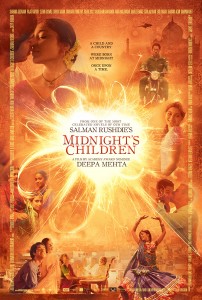 For a whole generation of readers, particularly Indians or South Asians, the act of watching the new movie “Midnight’s Children” is always going to be an act of nostalgia. “I was born in the city of Bombay … once upon a time.”
For a whole generation of readers, particularly Indians or South Asians, the act of watching the new movie “Midnight’s Children” is always going to be an act of nostalgia. “I was born in the city of Bombay … once upon a time.”
An advance screening of the film was held at the Metropolitan Museum of Art on April 9. Deepa Mehta, the film’s director, and Salman Rushdie, who has adapted his novel for film and also done the narration, were present at the event.
The nostalgia that the film evoked in me was less tied to the land it often portrays in gorgeous hues, and more about the novel that I had both remembered and forgotten. I remembered the book’s appeal to secularism. Mehta has rightly used in the film’s opening moments the clip from Prime Minister Nehru’s famous “at the stroke of the midnight hour” speech; and in the film we hear Satya Bhabha’s wistful, slightly limp, Baba-log appeal: “We have to stay together, na? Everything else is breaking apart.”
But what I had forgotten about the novel, and which the film goes some distance toward recovering, is the wonderful way in which Rushdie had relied on Hindi films to structure his novel and its language. No, I don’t simply mean the film-posters of “Mother India” that we see pasted on the walls. Rather, I’m thinking of the babies swapped at birth, the socialism of its most ordinary characters, the intertwined destinies of countless people populating the story, even the not-to-be-suppressed-for-long sentimentality, all of which owes a lot to Bollywood’s past.
In the movie, Mehta pays homage to Hindi films as well as Rushdie’s storytelling when two characters, caught in an illicit, doomed love affair, exchange an “indirect kiss” while sitting in a Bombay Irani restaurant in the fifties. The man kisses the glass of lassi from which he is about to take a sip. He pushes the glass toward his lover who picks it up and places her lips where a moment ago the other’s lips had been pressed.
All films about India have their past in Bollywood. But films about India also often have their past in Hollywood. I thought of “Slumdog Millionaire” a couple of times while watching “Midnight’s Children” — every time a white person shakes my hand they ask, “Did you like ‘Slumdog Millionaire?’”– and that might be because both films depict slums and violence. But there are differences. The biggest one is that Midnight’s Children is “Slumdog Millionaire” with a Ph.D. in History from Cambridge. Or something like that. This is good, of course, but it also puts a strain on the film during the latter half. While the novel, at around 600 pages, could afford to be capacious, the film has to hurry to tell the story of the self and the entangled histories of three of the biggest nations in South Asia.
In a conversation after the film, Rushdie said that when he was at the Telluride Film Festival he heard a comment someone made about the movie “Midnight’s Children”: “It’s like ‘Forrest Gump,’ with brown people.” (In the film, Saleem Sinai repeats a shorter version of the claim he had made in the book: “I had been mysteriously handcuffed to history, my destinies indissolubly chained to those of my country.”) Rushdie said that it was actually the other way around — after all, the novel had been written decades before “Forrest Gump.” “So ‘Forrest Gump’ is ‘Midnight’s Children,’ with white people.”
Amitava Kumar is the author of several books, including A Foreigner Carrying in the Crook of His Arm a Tiny Bomb. He is a professor of English at Vassar College. Midnight’s Children opens Friday, April 26 at select theaters.












